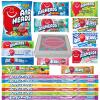Let's settle this once and for all; wine gums don't contain a single drop of wine. Never have, never will. Yet this chewy British classic has been confusing for over a century, and I'm here to spill all the secrets about these peculiar sweets that have nothing to do with alcohol but everything to do with British confectionery genius.
Do Wine Gums Contain Alcohol? The Myth That Won't Die
Here's the truth: wine gums are completely alcohol-free. Despite being labelled as Port, Sherry, and Champagne, these sweets have never contained wine or any other form of alcohol. The confusion runs so deep that in 2009, a teenager in Cambridgeshire was refused purchase at a 99p Store because the shop worker thought they contained alcohol and required customers to be over 18. The store had to apologise and offer vouchers after the embarrassing mix-up.
So, why are they called wine gums? Charles Gordon Maynard invented them in 1909, and he had quite the challenge convincing his strict Methodist and teetotaler father about the name. Charles Riley Maynard was so opposed to anything associated with alcohol that his son had to work hard to get approval.
The most likely story? Charles Gordon wanted to create sophisticated sweets for adults that could be savoured like fine wine, minus the alcohol. Think of it as the confectionery equivalent of a mocktail, designed to give teetotallers something fancy to enjoy while others sipped their port.
The ingredients tell the real story. Wine gums contain glucose syrup, sugar, modified corn starch, gelatin, and fruit flavourings. That's it. No wine, no alcohol extract, no fermentation - just good old-fashioned sweet ingredients that create that distinctive chewy texture we know and love. If you're browsing our collection of jelly and gummy sweets, you'll find wine gums sitting happily alongside other alcohol-free treats.

A Sweet Story That Started in a Stamford Hill Kitchen
The wine gum story begins in 1880 when Charles Riley Maynard and his brother Tom started making sweets in their kitchen in Stamford Hill, North London. Charles's wife, Sarah Ann, ran a sweet shop next door, selling their homemade confections to locals. By 1896, they'd officially formed the Maynards sweet company, and by 1906, they'd built a proper factory in Harringay with access to clean spring water and railways for shipping ingredients. (Source: Imperial War Museums)
But the real breakthrough came in 1909 when Charles Gordon Maynard created wine gums. The young Maynard had a vision for sweets that adults could enjoy without feeling childish. Each gum was stamped with sophisticated wine names, including Port, Sherry, Champagne, Burgundy, and Claret, and came in five distinctive shapes: kidney, crown, rhombus, circle, and oblong. These weren't your typical penny sweets; they were marketed as refined treats for discerning palates. (Source: Wikipedia)
The company's journey reads like a proper British business saga. After decades of family ownership, Cadbury bought Maynards in 1988. The brand merged with Bassett's and Trebor in 1990, production moved to Sheffield in 1991, and the original London factory closed its doors in 1998. Today, wine gums are manufactured by Maynards Bassetts, which Mondelez International owns, but they still follow the original recipe that made them famous. By 2002, wine gum sales had reached £40 million annually, and the UK gum market was valued at £376 million in 2022. (Source: Wikipedia)
What Makes Wine Gums so Chewy? The Science Behind The Texture
Ever wondered why wine gums have that distinctive, firm chew that sets them apart from your average gummy bear? It's all down to the manufacturing process, which is far more complex than you'd think. The traditional starch mogul process takes 48 to 72 hours from start to finish, creating that perfect texture that's neither too soft nor tooth-breaking hard.
The magic happens when the mixture of glucose syrup, sugar, and modified cornstarch is cooked at temperatures between 90 and 120°C. The hot mixture is then deposited into cornstarch-filled trays with pre-stamped cavities, one for each shape. Here's where patience comes in: the sweets cure for two to three days while the starch absorbs excess moisture, creating that signature firmness. After demolding and cleaning, they get a coating of carnauba wax to prevent sticking and add that subtle shine.
What really sets wine gums apart is their moisture content, which is just 15-20%, compared to 20-25% in softer gummies. Less moisture means a firmer texture and longer-lasting chew. The modified corn starch creates a more rigid gel matrix than gelatin alone would, which is why wine gums don't dissolve in your mouth like jelly babies do. Some enthusiasts even age their wine gums deliberately, leaving packets open to dry out further for an extra-firm texture. If you're after traditional wine gums in smaller portions, you can experience this unique texture for yourself.
Are Wine Gums Suitable for Vegetarians? The Ingredient Breakdown
Bad news for vegetarians: traditional wine gums contain gelatin, which is derived from either pork or beef. This makes them unsuitable for vegetarians, vegans, and those following halal or kosher diets. The gelatin gives wine gums their characteristic chew, but it does mean they're off the menu for quite a few people.
But don't despair if you're plant-based! Manufacturers have responded to the demand for vegan wine gums, using alternatives such as cornstarch, pectin, or agar instead of gelatin. These vegan versions aim to replicate that classic wine gum texture without any animal products. The taste is spot on, though some say the texture isn't quite as firm as the original.
Nutritionally, wine gums pack quite a punch. Per 100g, you're looking at 350-354 calories, with about 78-83g of carbohydrates and 55-65g of sugar. That's roughly 90% of the calories coming from carbs. A typical serving of four pieces contains around 85 calories. They're fat-free and contain about 6-7g of protein per 100g (thanks to that gelatin), but let's be honest - nobody's eating wine gums for the protein content. The high sugar content means they're not suitable for diabetics, and some varieties may contain sulfites from glucose syrup processing, which could affect those with sensitivities.

Red vs Black: Which Wine Gum Flavour Reigns Supreme?
According to Cadbury's own data, red and black are the most popular flavours of wine gums, and there's quite a bit of passion surrounding this debate. The black ones, usually blackcurrant, have a devoted following who'll dig through mixed bags to find them. Red wine gums vary depending on where you are: in the UK, they're typically strawberry or raspberry, while American versions lean towards cherry. (Source: Wikipedia)
The complete flavour line-up reads like a fruit salad:
- Red: Strawberry, raspberry, or red berry
- Black: Blackcurrant (the undisputed champion)
- Yellow: Lemon
- Green: Lime
- Orange: Orange or tangerine
- White/ or Cream: The mysterious one (could be grapefruit, pineapple, or pear, depending on the brand)
Different manufacturers put their own spin on things. Maynards Bassetts stick with the traditional wine names, while Haribo's version includes Gin and Hock alongside Port and Sherry. Lion Confectionery, with over 100 years of experience in sweet-making, produces a firmer version that some purists swear by. The flavours might be fruit-based rather than wine-based, but each brand has its loyal followers who'll argue their version tastes best.

Wine Gums Around The World: A Commonwealth Connection
Wine gums have travelled far from their North London origins, becoming beloved treats throughout the Commonwealth. They're huge in Canada, where Maynards became the number one candy brand with local production in Toronto. You'll find them in Ireland, South Africa, Australia, and New Zealand, often in the international aisle next to other British classics.
The texture and flavour profiles change slightly depending on where they're made. UK production (now in Sheffield) is considered the gold standard, with Canadian-made versions sometimes criticised for being somewhat different in texture. Haribo produces theirs in Pontefract, England, specifically for the UK market, recognising that British consumers have distinct expectations for their wine gums. Browse our blog to learn more about how British sweets compare to confectionery from other countries.
In America, wine gums remain relatively unknown, except in British import shops and online retailers. Swedish Fish fill a similar niche; they're technically wine gums or starch jellies, made with starch instead of gelatin for that characteristic chew. Interestingly, Swedish Fish and wine gums are now made by the same parent company, Mondelez International, and sometimes share manufacturing facilities. Import pricing can be steep; a 165g bag that costs £1.25 in the UK might set you back $6-11 in the States.
How Wine Gums Compare to Other British Sweets
Wine gums occupy a unique spot in the British sweet hierarchy. They're firmer than jelly babies, less sweet than fruit pastilles, and more sophisticated than your average gummy bear. Each comparison reveals something about what makes wine gums unique.
Take fruit pastilles; they're sugar-coated, sweeter, and contain 25% fruit juice. Wine gums have no sugar coating and rely on artificial flavours, making them less sweet but longer-lasting. Jelly babies are soft, starch-dusted, and baby-shaped, clearly aimed at children. Wine gums, with their wine-themed names and firm texture, were always meant for grown-up tastes. When compared to American sweets that have become popular in the UK, wine gums represent that distinctly British preference for sweets that aren't overly sugary.
Midget gems share some DNA with wine gums; they're firm and fruit-flavoured, but they're smaller, more complex, and traditionally sold loose from jars. Gummy bears, the German import that has conquered the world, are softer, sweeter, and often coated in sugar. Wine gums stand apart with their unique combination of firmness, subtle flavours, and that satisfying chew that lasts ages. You can explore our bulk jelly and gummy sweets selection to compare different textures and flavours yourself.

That’s All Folks
Wine gums remain one of Britain's most misunderstood sweets, but perhaps that's part of their charm. From Charles Gordon Maynard's kitchen experiments to today's £376 million market, these alcohol-free, wine-named treats have earned their place in confectionery history. Whether you're team red or team black, prefer them fresh or aged to perfection, there's something special about a sweet that's remained essentially unchanged for over a century.
Next time someone asks if wine gums contain wine, you can set them straight with confidence. Better yet, share a bag and let them discover the truth for themselves; that wine gums are proof you don't need alcohol to create something worth savouring. Ready to taste the truth? Begin your wine gum journey with our selection of traditional and vegan varieties, available in a range of sizes, from pocket-sized packets to bulk bags for serious enthusiasts.






Leave A Comment